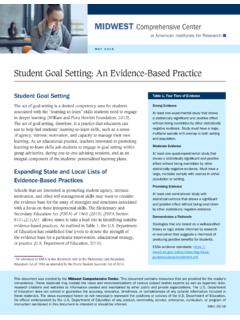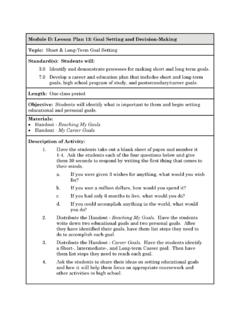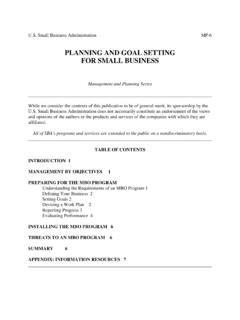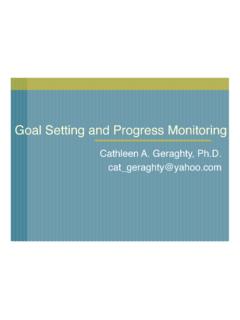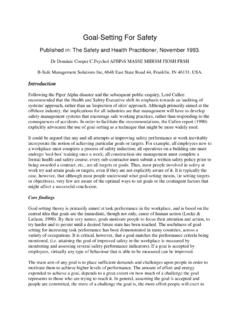Transcription of Goal Setting, Problem Solving and Learning
1 goal setting , Problem Solving and Learning Developed and Produced by Educational Services & Technologies (EST). Copyright, November 2005. Influences on Academic Success Academic success is influenced by your use of effective Learning and study methods. Academic success is influenced by your effective management of your time. Academic success is influenced by you having concretely stated goals and strategies to accomplish the goals. Academic success is influenced by you effectively Solving academic, personal and social problems. Influences on Academic Success Academic success is influenced by your effective management of anxiety and stress.
2 Academic success is influenced by your use of effective listening and communication skills. Academic success depends on your use of effective decision making skills. The purpose of this presentation is to introduce you to Effective goal setting and Problem Solving . You will profit the most if you are actively involved. Do each exercise while thinking of your personal situation. Set goals as you realize the importance of an idea to you. goal setting and Problem Solving (RBM). A Goal should, at the least, be Reachable, Believable and Measurable Beyond the Basics Setting Successful Goals In order to reasonably expect to achieve a goal, it must be stated so as to be: 1.
3 Conceivable - stated so those involved understand it 2. Believable - in terms of your values 3. Achievable - with your strengths or those you can draw on 4. Controllable - involvement of others require their permission 5. Measurable - in terms of a time table and deadlines 6. Desirable - something you really want to do 7. Stated with no alternatives 8. Growth facilitating Academic goal setting occurs within time limits and deadlines. goal setting and Problem Solving Think of the clock's face as representing the total amount of time for a week. Your goals are accomplished within the 168 hours for each week, the 24 hours of each day.
4 A goal cannot be efficiently accomplished without consideration of your daily use of time and the priorities of your life. Ways to Improve Daily Decision Making Long range projects should be divided into smaller units or parts. The smaller units or parts should be broken into activities that are clearly specified. Remember that many decisions make the whole. Following are several decision making models that will help in daily decision making. Decision Making Using SOCS. Situation - What is the Problem area, stated in realistic (objective) terms? Options - What choices do I have; good and bad/positive and negative?
5 Consequences - Which of my choices will hurt either me or someone else. Cross them out of your list. Solution Solutions will come from the choices you have left, after the consequences have been removed. SOCS = Situation, Options, Consequences &. Solutions Students set goals best when they have a sense of personal need or relevance. Seven (7) goal setting Areas Goals should at least address the following areas: 1) Goals which help you understand the institutional structure and rules;. 2) Goals which help you manage your time;. 3) Goals which help you communicate effectively in class and academic situations.
6 4) Goals which help you understand your textbook and improve your note taking skills;. Seven (7) goal setting Areas 5) Goals which improve your test preparation and test taking skills;. 6) Goals which help you control and reduce anxiety and stress due to academic rigor; and, 7) Goals which improve your Problem identification and Problem Solving skills. Bull's Eye Analogy A clearly stated academic goal defines the expected outcome clearly. A clearly . stated goal specifies behavioral actions and/or areas for thought control or modification that support goal accomplishment.
7 Self-Discipline, Attitude and Motivation (SAM). To stay on target academically depends upon visualizing your goals and follow through schemes. Follow through schemes should focus on behavioral and/or attitudinal areas. You might think of your behavioral and attitudinal goals as interwoven circles as seen in the illustration in the previous slide. To hit the Bull's Eye, which is academic success, you must focus your behaviors and thoughts, your arrows, so that you are academically successful. Remember SAM , Self-Discipline, Attitude and Motivation. An analogy would be that SAM is your backbone and it supports your academic success.
8 Using Your Thoughts and Actions Self-regulation is the process of students using their own thoughts and actions to reach academic Learning goals. Self-regulated learners identify goals and adopt and maintain their own strategies for reaching the goals. Schmuck, Richard A., :Group processes in the classroom [by] Richard A. Schmuck [and] Patricia A. Schmuck. Series: Issues and innovations in education, Dubuque, Iowa, W. C. Brown [1971]. Four Aspects of Self-Regulation goal setting Concrete measurable goals Self-Observation Recording progress Self-Assessment Measuring progress Self-Reinforcement Rewarding progress Personalize Your Goals You will set goals best when you have a sense of personal need or relevance.
9 goal setting and Problem Solving goal setting has an end result of regulating or changing behavior. Identifying areas for change involve Problem Solving . Defining goals should take into consideration at least 7 dimensions. Defining Problems for goal setting According to Arnold Lazarus's modalities for Problem definition, problems that impact behavior may impact 7 areas of behavior. The behavioral areas for Problem definition can be recalled by using the BASIC ID mnemonic. Lazarus, Arnold A, Brief but comprehensive psychotherapy : the multimodal way, New York : Springer Pub.
10 , c1997. Modalities of Behavior Problem Definition 1. Behavior - What things do you do or what habits do you have that reduce your academic, social, or interpersonal performance? 2. Affect - These are your emotional states. What feelings and emotions do you have that are troublesome, that you believe interfere with your performance? 3. Sensation - These are physical states - headaches, muscle tension aches, etc. that affect your performance. What physical reactions interfere with your performance? Modalities of Behavior Problem Definition 4. Imagery - These are imaginative states - daydreams, images, and the like - that are unpleasant and hamper your performance.
